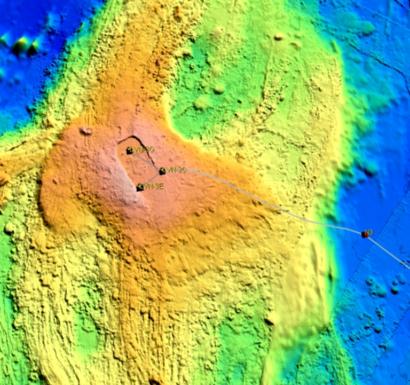OOI Mapping Cruise 2008
Node 3, Axial Seamount
Axial Volcano has the most robust magma supply on the Juan de Fuca Ridge.
Understanding Submarine Volcanoes
Two of the outstanding problems in marine sciences are understanding how submarine volcanoes support life in the absence of sunlight and the impact of perturbation events such as magmatic intrusion and earthquakes on geological, chemical and biological processes. Further advances in these studies are increasingly dependent on our ability to collect long-term, high-frequency observations using diverse networks of sensors and samplers. The major volcanic, magmatic and tectonic events that create the oceanic crust and modulate the fluxes of heat, chemicals and biological material across the seafloor and associated health of the biological communities are inherently episodic on decadal time scales and they are also short-lived. Transient events such as magmatic eruptions at mid-ocean ridges increase carbon dioxide output and venting volume by as much as a factor of 100, resulting in extensive microbial blooms.
A Robust Volcanic System
Axial Seamount is the most robust volcanic system on the Juan de Fuca Ridge and it is seismically, magmatically, and hydrothermally active. To begin to understand process linkages at mid-ocean ridge spreading centers, infrastructure at Axial Seamount includes the backbone high-voltage node that hosts a full water-column mooring with profiling capabilities and a suite of core chemical and physical sensors, and a low-voltage benthic node that provides communication to the core suite of geophysical instruments.
Instruments at Node 3
Node 3 will be located in a benign area roughly 20 km down slope and east of the seamount. A secondary node located on the southeast portion of the summit will provide power to a series of low-voltage nodes that allow access to the Ashes hydrothermal vent field and to the central portion of the volcanic caldera. The secondary node will also host a broadband and short-period seismometer as well as a bottom pressure recorder and tilt meter. A suite of chemical, physical oceanographic and biological sensors will be located in and near vigorously venting chimneys and diffuse vent sites at Ashes. Additional short-period seismometers, and coupled pressure sensors and tilt meters will also be placed at these sites. A ~ 5-km extension cable will extend up the center of the caldera and will host two short-period seismometers, and coupled pressure sensors and tilt meters to examine inflation/deflation of the volcano and earthquakes associated with melt and fluid flow.


